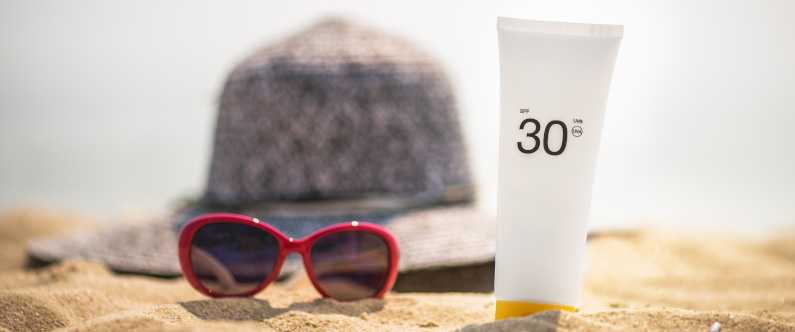Summer, Sun, and Sunscreen
 It is recommended to use SPF-30 for day-to-day use and SPF-50 if outdoors for an extended time
It is recommended to use SPF-30 for day-to-day use and SPF-50 if outdoors for an extended time
Authors: Dr. Amit Abraham, Dr. Sohaila Cheema, and Dr. Karima Chaabna
Although sunlight is essential for human health and wellbeing, we must be cautious of solar ultraviolet radiation (UVR). UVR can neither be felt nor seen.
Two types of UVR are of particular concern—UVR-A and UVR-B. UVR can cause harm in several ways:
- Sunburn is the most common effect of UVR on the skin.
- Over time, UVR can cause wrinkles, age spots, other signs of aging, and certain types of skin cancers.
- UVR can also damage the eyes. In rare cases, the eyes can experience ‘sunburn’ acutely, whilst long-term exposure is associated with the development of cataracts, corneal damage, and loss of eyesight.
Factors Affecting UVR Exposure
UVR exposure can vary depending on a plethora of factors:
- Exposure to UVR is highest between 10:00 am and 4:00 pm.
- Summer tends to have the most direct UVR during the year.
- The intensity of UVR is higher in areas closer to the equator since radiation has less distance to travel.
- UVR exposure is more at elevation compared to sea level.
- Exposure to UVR peaks with clear skies but can still be high when it is cloudy.
- UVR-B gets absorbed by glass, but not UVR-A. Be mindful of exposure behind a window, in your home, car, or elsewhere.
Protection from UVR – Sunscreen
Sunscreen works by absorbing or reflecting UVR before it can penetrate your skin. There are two types of sunscreens: chemical and physical. Chemical sunscreen causes the UVR to undergo a chemical reaction, rendering it harmless, while physical sunscreen reflects the UVR. Both types are effective, but physical sunscreen, the primary constituent of which is zinc or titanium dioxide, is generally considered safer, longer lasting, and less irritating to the skin. Sunscreen is not recommended for infants under six months. Instead, they should be kept away from direct sunlight or don protective clothing and brimmed hats.
The Sun Protective Factor (SPF) value measures how well a sunscreen protects against UVR exposure. It is recommended to use SPF-30 for day-to-day use and SPF-50 if outdoors for an extended time.

While sunscreen is essential for protecting the skin, some ingredients in sunscreen can also harm the environment. Chemical sunscreens have been found to be toxic to coral reefs and marine life. Look for sunscreens that are labeled as “reef-safe” or “ocean-friendly.” These sunscreens typically use physical blockers instead of chemical blockers.
Tips to Apply Sunscreen
- Sunscreen must be applied generously to all exposed areas of the skin.
- Everyone needs sunscreen, no matter their skin complexion.
- Ensure your sunscreen is labeled ‘broad-spectrum,’ which protects against both types of UVR.
- Apply 15 minutes before going outside.
- Reapply every two hours or more often if you have been swimming or sweating.
- Use sunscreen even on cloudy days, as UVR can penetrate clouds.
- Don’t forget to apply to your ears, nose, lips, hands, back of the neck, top of the feet, and crown of the head (if the hair is thinning).
- While some makeup contains SPF, this usually doesn’t provide adequate protection. Apply sunscreen to any exposed skin before or after makeup application (the order doesn’t matter).
Other Tips to Minimize UVR Exposure
You can limit your UVR exposure by following these steps:
- Avoid prolonged periods in the sun between 10:00 am and 4:00 pm.
- When you do go outside, wear protective clothing, such as a wide-brimmed hat and a long-sleeved shirt. Keep an umbrella handy.
- Wear wrap-around sunglasses that provide both UVR-A and UVR-B protection.
- Stay in shaded areas, under the cover of trees or buildings.
- When at the beach or pool, wear sun-protective swimwear.
- Avoid indoor tanning beds, as they emit high levels of UVR.
- Take extra precautions if you have a history of skin cancer in your family
In conclusion, you can safely enjoy the outdoors if you minimize your exposure to the sun, wear protective clothing, and apply sunscreen. Stay safe, and enjoy the summer!
Sources: World Health Organization (WHO) | Johns Hopkins Medicine | Mayo Clinic | US Food and Drug Administration (FDA)
Editor: Julietta Mirghani